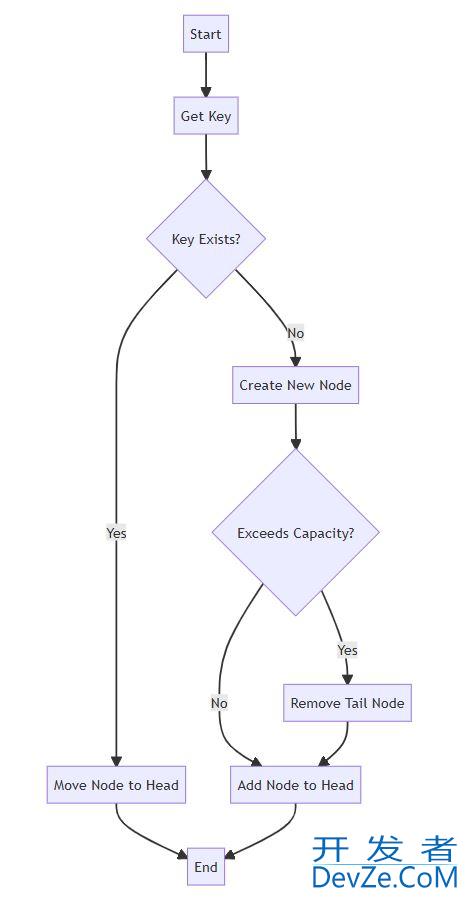使用Go语言实现LRU缓存的代码详解
目录
- 引言
- LRU 缓存的关键特性
- 数据结构选型
- LRU 缓存的结构设计
- 操作流程图
- 代码实现
- 1. 定义节点和缓存结构
- 2. 初始化 LRU 缓存
- 3. 获取缓存值(Get 方法)
- 4. 更新或插入值(Put 方法)
- 5. 辅助方法
- 6. 单元测试代码
- 总结
引言
在日常开发中,缓存是提高系统性能的重要手段。LRU(Least Recently Used)缓存是一种基于“最近最少使用”策略的缓存系统,其目的是在空间受限的情况下保留最新、最常用的数据。当缓存空间不足时,LRU 缓存会优先淘汰最久未被使用的数据,从而保持缓存的时效性。本文将详细讲解如何使用 Go 语言实现一个 LRU 缓存。
LRU 缓存的关键特性
- 快速访问缓存内容:
Get操作的时间复杂度为 (O(1))。 - 快速插入和更新缓存:
Put操作的时间复杂度也为 (O(1))。 - 淘汰最久未使用的数据:当缓存满时,移除最久未访问的数据。
数据结构选型
为了实现 LRU 缓存的上述特性,常用的数据结构组合为 哈希表 和 双向链表:
- 哈希表:用于快速访问缓存节点。
- 双向链表:管理节点的访问顺序。每次访问时,将节点移动到链表头部;当缓存满时,移除链表尾部节点(即最久未访问的数据)。
通过这种组合,Get 和 Put 的时间复杂度均为 (O(1))。
LRU 缓存的结构设计
在 LRU 缓存的设计中,我们需要以下两js个核心组件:
双向链表节点
Node:- 存储缓存的
key和value。 - 通过
prev和next指针指向前后节点。
- 存储缓存的
LRUCache 缓存结构:
capacity:缓存的容量。cache:使用map[int]*Node作为哈希表,存储键值对和链表节点的映射。head和tail:虚拟头尾节点,用于链表的边界处理,避免在插入和删除操作时对边界条件进行额外判断。
操作流程图
下面是 LRU 缓存的整体操作流程概览:

代码实现
1. 定义节点和缓存结构
我们首先定义双向链表节点 Node 和 LRUCache 结构:
package main
import "fmt"
// 双向链表的节点
type Node struct {
key, value int
prev, next *Node
}
// LRUCache 缓存结构
type LRUCache struct {
capacity int
cache map[int]*Node // 哈希表,快速定位节点
head, tail *Node // 虚拟头尾节点
}
2. 初始化 LRU 缓存
在 Constructor 方法中,初始化缓存容量 capacity 和哈希表 cache,并创建 head 和 tail 虚拟节点。head 和 tail 之间没有数据节点,它们仅用于简化tKlsUvhyRv节点插入和删除的边界处理。此时,链表初始状态如下:
head <--> tail
初始化代码如下:
// 构造函数
func Constructor(capacity int) LRUCache {
cache := LRUCache{
capacity: capacity,
cache: make(map[int]*Node),
head: &Node{},
tail: &Node{},
}
cache.head.next = cache.tail
cache.tail.prev = cache.head
return cache
}
3. 获取缓存值(Get 方法)
Get 方法根据 key 查找缓存中的数据。如果数据存在,则将该节点移到链表头部,标记为“最近使用”;如果数据不存在,则返回 -1。
// 获取缓存中的值
funphpc (this *LRUCache) Get(key int) int {
if node, found := this.cache[key]; found {
this.moveToHead(node) // 访问后移至头部
return node.value
}
return -1 // 如果不存在,返回 -1
}
在调用 moveToHead 方法时,节点被移动到链表头部。假设我们在链表中有节点顺序:head <-> A <-> B <-> tail,访问 B 后,链表状态变为:
head <--> B <--> A <--> tail
4. 更新或插入值(Put 方法)
Put 方法根据 key 更新值,或在缓存中插入新的键值对。如果缓存超过容量限制,则移除链表尾部的节点。
// 更新或插入值
func (this *LRUCache) Put(key int, value int) {
if node, found := this.cache[key]; found {
node.value = value
this.moveToHead(node) // 已存在的节点移至头部
} else {
// 创建新节点并加入头部
newNode := &Node{key: key, value: value}
this.cache[key] = newNode
this.addNode(newNode)
// 超js出容量时,删除尾节点
if len(this.cache) > this.capacity {
tail := this.popTail()
delete(this.cache, tail.key)
}
}
}
当缓存满时,popTail 方法删除链表尾部节点。假设链表当前状态为:head <-> B <-> A <-> tail,插入新节点 C 后,链表状态变为:
head <--> C <--> B <--> tail
节点 A 被淘汰,从而控制了缓存的空间限制。
5. 辅助方法
addNode、removeNode、moveToHead 和 popTail 是缓存核心操作的辅助方法,用于管理链表中节点的插入、删除和移动。
// 添加节点至头部
func (this *LRUCache) addNode(node *Node) {
node.prev = this.head
node.next = this.head.next
this.head.next.prev = node
this.head.next = node
}
// 删除节点
func (this *LRUCache) removeNode(node *Node) {
prev := node.prev
next := node.next
prev.next = next
next.prev = prev
}
// 移动节点到编程客栈头部
func (this *LRUCache) moveToHead(node *Node) {
this.removeNode(node)
this.addNode(node)
}
// 弹出尾部节点
func (this *LRUCache) popTail() *Node {
tail := this.tail.prev
this.removeNode(tail)
return tail
}
插入节点到链表头部的图示
addNode 方法的核心步骤如下:假设链表初始状态为 head <-> A <-> B <-> tail,插入新节点 node 到 head 后,链表状态变为:
head <--> node <--> A <--> B <--> tail
6. 单元测试代码
为验证实现正确性,可以使用以下测试:
import "testing"
func TestLRUCache(t *testing.T) {
cache := Constructor(2)
cache.Put(1, 1)
cache.Put(2, 2)
if cache.Get(1) != 1 {
t.Errorf("Expected 1, got %d", cache.Get(1))
}
cache.Put(3, 3) // 淘汰 key 2
if cache.Get(2) != -1 {
t.Errorf("Expected -1, got %d", cache.Get(2))
}
cache.Put(4, 4) // 淘汰 key 1
if cache.Get(1) != -1 {
t.Errorf("Expected -1, got %d", cache.Get(1))
}
if cache.Get(3) != 3 {
t.Errorf("Expected 3, got %d", cache.Get(3))
}
if cache.Get(4) != 4 {
t.Errorf("Expected 4, got %d", cache.Get(4))
}
}
总结
通过双向链表和哈希表的结合,实现了一个高效的 LRU 缓存,使 Get和 Put 操作在 O(1) 的时间内完成。双向链表和虚拟节点的设计简化了链表边界的处理,广泛适用于缓存系统中。
以上就是使用Go语言实现LRU缓存的代码详解的详细内容,更多关于Go实现LRU缓存的资料请关注编程客栈(www.devze.com)其它相关文章!






 加载中,请稍侯......
加载中,请稍侯......
精彩评论